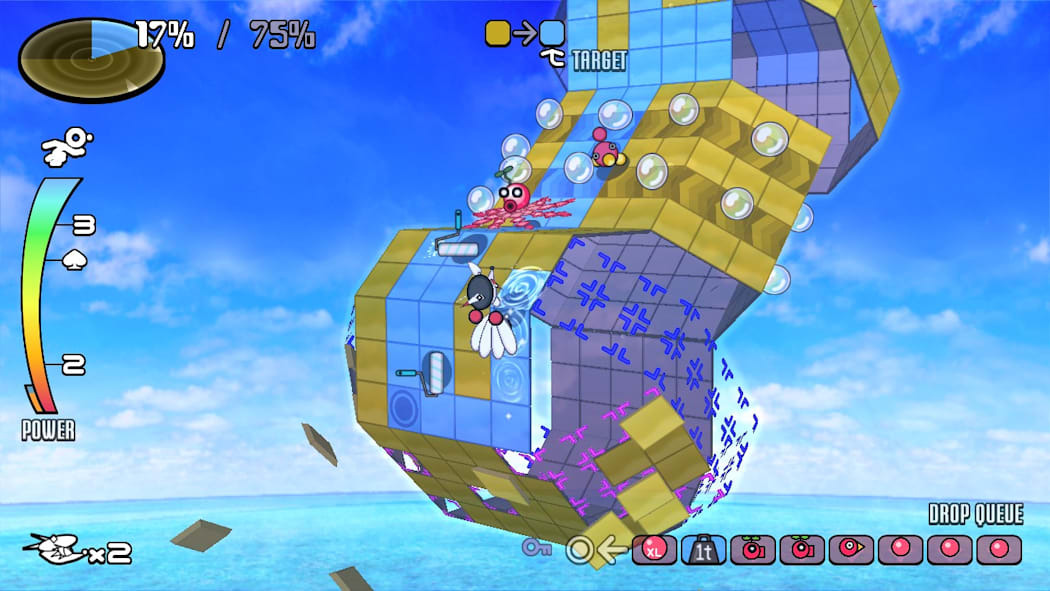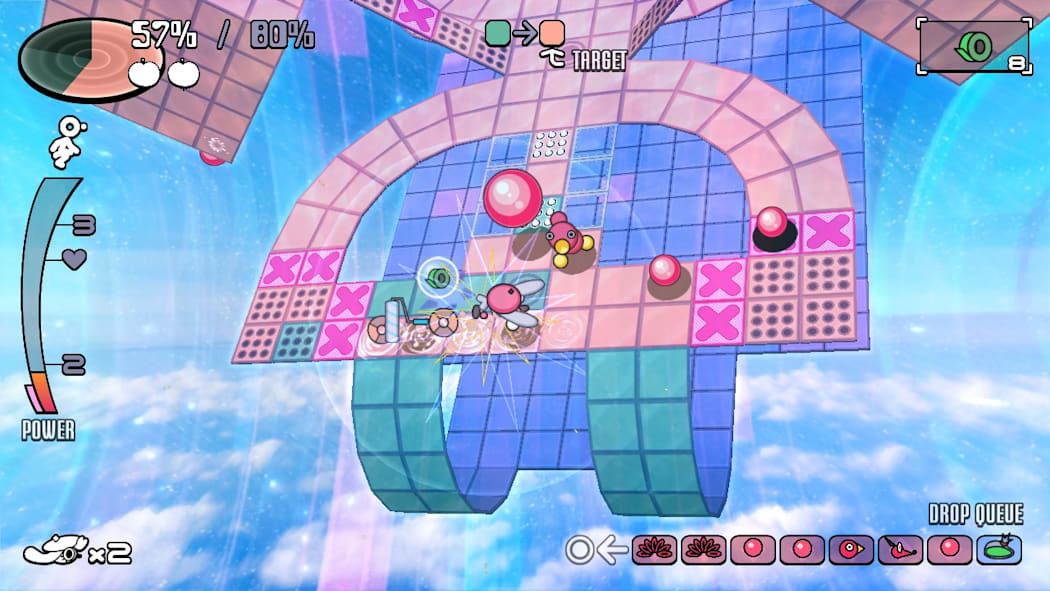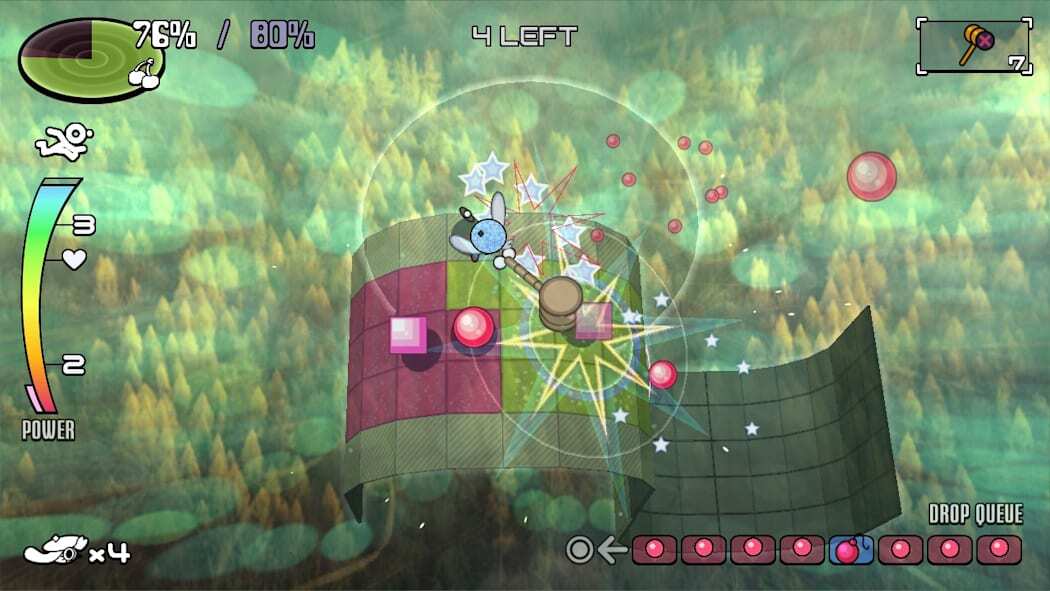The indie game space is great at reviving aesthetics and gameplay loops that we were all once beholden to. Just take a look at the numerous shmups, dungeon crawlers, and platformers that line the Steam shop. However, the majority of these games look to either the 80s or 90s for their vibes.
Over the last year or so, the aesthetic tide has begun to turn to the early 2000s ‘Y2K’ brand of retro-futurism and Japanese-flavored quirkiness. Games like Bomb Rush Cyberfunk, Crossniq+, and even Zenless Zone Zero all delve back into cel-shaded, bold-outlined goodness. There is another common thread between the early 2000s and current genre revivals: Arcade puzzle games. I always knew the Dreamcast, GameCube, and PS2 puzzle games I’d see on episodes of Cinematech growing up were special, and they still transport me back to those breezy days.
This is where solo developer Jaklub’s Vividlope enters the arena, and man, does it make a worthy contender. Released on Steam last year, Vividlope features you walking and jumping in eight directional movements around floating geometry made out of tiles to leave them painted in a specific color. Think of a less aggressive Splatoon. This makes for a pretty simple premise. It’s when you factor in the constantly spawning enemies, mesmerizing backgrounds that you’d see as a Windows screensaver in 2001, and a chilled drum & bass, synth-textured soundtrack that the game becomes utterly intoxicating. I was reminded of the score chase of Pac-Man or Q-Bert, but with the pristine vibes of Super Monkey Ball or ChuChu Rocket. You see, Vividlope is the kind of pick-up-and-play game that quickly gets its claws in you. It would fit perfectly on a PSP or take plenty of tokens from you in an arcade. Once you witness the cool pastel-soaked, dreamy way the game presents itself, you can’t help but play another level. And then another. What time is it? 3 AM, but it’s 3 PM somewhere, right? And somehow, you still want to keep going.

Vividlope’s on the Nintendo Switch now, and that’s why I’m here telling you it’s a game that fits the system perfectly. Next to Tetris Effect, I don’t think I’ve ever experienced another puzzle game that so effortlessly feels like it was made for a system. And despite being multi-platform, it somehow is in its definitive state on the Switch. One of the brilliant ways that Vividlope keeps you playing is by giving you multiple ways to engage with its concept. Story mode packages stages into an interactive hub world known as the Vividscape, where the two bunny mascots for the game, Cookie and Cre—I mean, Cerise and Ecru—have found themselves after being sucked into their television. And now they’re the stars of their own goofy cartoon. Even the plot for the game takes me back to the early 2000s, where depictions of virtual reality and the romanticism of a Gateway desktop with an AOL dial-up internet subscription were all over pop culture. As the internet has become more complicated, so too has gaming. Vividlope transports not only its characters to a simpler time in technology but its players as well.
In story mode, you go from world to world, with each world consisting of 10-15 stages, allowing you to tackle stages in any order. At the end of each stage, you get ranked from E (lowest) to S (highest) depending on how quickly you painted the stage, how many times an enemy took one of your stocks, and how much of the stage you were able to cover in the bonus phase. Bonus phases are Vividlope’s way of testing your ability to navigate the stage. Your goal is to cover the remainder of the stage after getting to 80% coverage. This is what makes your routing through a stage pivotal. Already painted blocks take speed away from the meter on the left side of your screen, and once that meter runs out, the stage is over. Either that, or you were able to cover 100% of the stage, and the game will account for that. Depending on difficulty, you can also acquire a V rank in each stage, which is only accessible if you play Story mode on the hard difficulty or higher. I found this one of the better applications of Sonic Adventure’s ranking system.

Getting through all 10 worlds will require you to cover as much of each stage as possible without losing lives. Thankfully, helpful items spawn just like enemies do. You can keep track of what will spawn next in the bottom right of the screen. I found it interesting that enemies and items will spawn regardless of whether you are moving or not. It’s as if each stage would have life with or without you. Anyway, items! Each item not only has the ability to defeat enemies, but they also cover larger parts of the stage than you do with just simple footsteps. Hammer stamps, paint guns, ribbon tape, dashes, shields, and body slam weights are all effective in their own ways. You can purchase any of these, as well as extra lives, from a shop between levels in story mode.
What’s more, is that you are able to select between three different characters, and depending on who you choose, your means of progressing and surviving through a stage change drastically. Cerise can take an extra hit from an enemy without losing a life so long as her power (speed) bar is sufficiently filled. Ecru can reach speeds that the other characters cannot but dies in one hit. And Miss Noir, the character exclusive to the Nintendo Switch version of Vividlope, can spawn items using her power bar and is by far the most efficient character to play as. That’s not to say the other two don’t have their strengths, but having items at your disposal at all times is a massive game-changer. The catch is that once you select a character, you must play as that character through the entire story mode without getting an option to switch them out.
So, we covered story mode. There is also an Endless mode, a staple of the puzzle game genre. Endless is my preferred way of playing Vividlope. It is perhaps the most arcade-like of all the modes. You select a character, get a set number of lives, and start playing through a stage rotation exclusive to this mode. There is no ranking system. You simply need to clear each level to move on to the next. There’s no level select wheel to scroll through, no hub world, and no real framing for the game’s concept. It feels like getting an ‘arcade’ version of Vividlope vs the ‘home console’ version of the game that is Story mode. This felt perfectly tailored for handheld mode.

Lastly, there is Gauntlet mode. It’s unique in that it gives a random selection of nine stages that you are tasked with playing through in order to achieve a score. This score is then critiqued by Miss Noir. I really enjoyed the personality provided by this mode. Not only does the random nature make replaying this mode a given, but it also has great party game sensibilities. I can imagine grouping some of my friends together and seeing which of us has to play through the most difficult stages on our roll. In addition to this, you can view the stage backgrounds, enemy types, TV episodes, and tutorial in the extras menu. That’s a lot of content, the likes of which I just haven’t really seen since the GameCube days.
With all of this being said, Vividlope is simple to understand but difficult to master. To say that later levels get anxiety-inducing is an understatement. Tiles start requiring multiple footsteps to achieve a desired color for the stage. Enemies can spawn every 2 seconds, your work on a stage can be undone, your routing can become fixed depending on the type of tiles in play, and you can die by jumping onto the wrong type of block, i.e., spikes, crossed-out blocks, etc. Vividlope’s vibe shifts accordingly from relaxing and inviting to frantic and claustrophobic. This shift will not hit with every player. Enemies close in on you constantly, and the game begins to feel impossible. But the game does its best to prepare you. Each world regularly introduces several new mechanics that are explained at the beginning of each stage all the way up until the very end. Overwhelming is the word I would use when attempting to recall everything demanded of me by world 8. For this reason, Vividlope is one of the most satisfying games of stage mastery I’ve ever experienced. Getting better ranks for clearing stages more efficiently scratches the same itch that finding new stage skips in Super Monkey Ball does. You can break this game right open with the right character choice and layout studying. Replay value for what will boil down to many as a simple throwback arcade game is surprisingly high. Best of all, the barrier for entry is a low $10. I found a generous helping of content for this price.

Vividlope was a transcendent experience for me. It brought me back to the days of quirky SEGA titles like ChuChu Rocket! and Super Monkey Ball. It also reminded me of the reason I love puzzle games from the early 2000s. For some reason, when you booted games like Wetrix or Bombastic up, they always took place in a void. The stage floated in midair like a planet in a far-off galaxy, surrounded by trippy blue, purple, red, and green backgrounds. Something about this soothes me. It only makes sense to translate this idea to Windows desktop backgrounds and screensavers comprising that otherwise empty void. For Vividlope, this makes for one hell of a time capsule and one sweet puzzler that I can see myself revisiting for a long time
Leave a Comment

